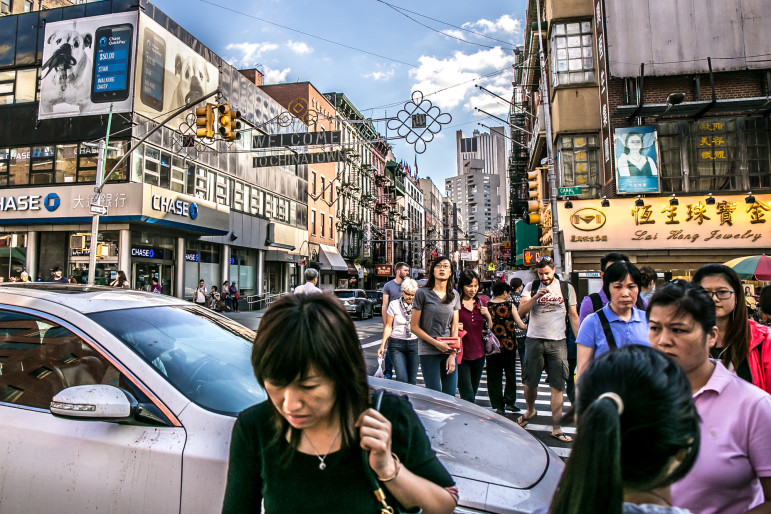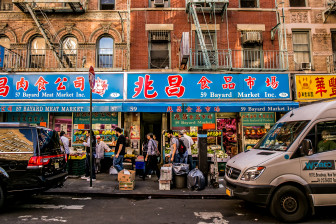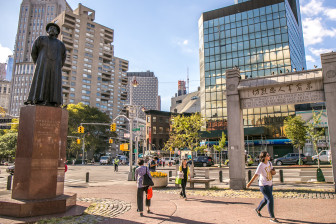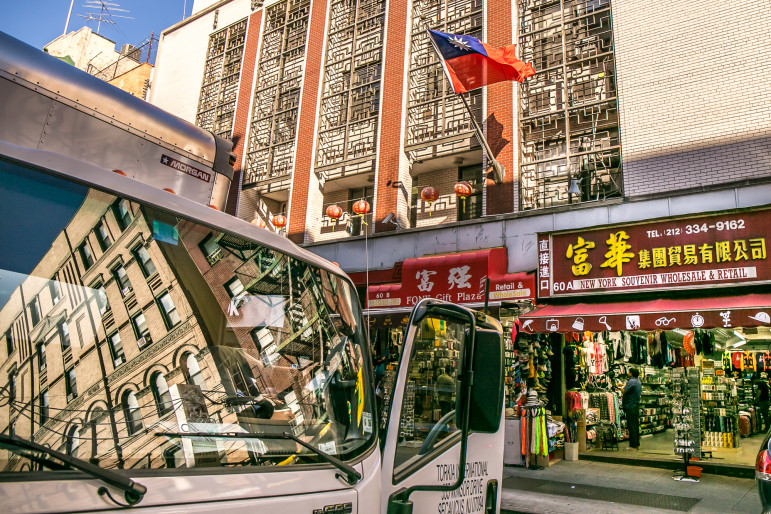
Adi Talwar
No longer the haven for immigrants that it once was, today's Chinatown is a hotspot for real-estate speculation and luxury development.
The Department of City Planning is calling for rezoning proposals in neighborhoods across the city. But community groups that have drawn up a detailed plan in one neighborhood are having a hard time getting the de Blasio administration to accept their vision for the future.
“We’d like to move up on the list of neighborhoods,” says Gigi Li, chair of Community Board 3, which covers Chinatown and the Lower East Side. “We’ve spent seven years putting together a very community-driven plan…Take a look at us.”
The Plan for Chinatown and the Surrounding Areas is the baby of the Chinatown Working Group (CWG), an assembly formed in 2008. At its high point, the CWG included around 60 organizations, including three community boards, tenant activists, business advocates, and community development groups. The plan entails creating a “Special District” encompassing a large swathe of The Lower East Side and Chinatown, including over half of Community Board 3 and parts of Community Board 1 and 2. The Special District would institute a variety of strategies to maintain the neighborhood’s affordability for low-income immigrants, including limiting density in some areas, while encouraging affordable housing development in others.
In February, the Department of City Planning (DCP) expressed concern about the breadth of the proposal. “We have concluded that the Special Chinatown and Lower East Side Zoning District is not feasible at this time,” wrote DCP Director Carl Weisbrod in a letter to Community Board 3 last February. He extended the offer to work with Chinatown groups to craft a narrower plan.
“In the spirit of our shared vision, we believe there are targeted areas of opportunity within the boundaries of your proposal that can…help to advance the mayor’s overarching goal of making New York a more equitable city.”
Throughout the summer, DCP has met with multiple community groups to discuss the plan, but has continued to request a tidier proposal with a smaller emphasis on preservation—while not offering many details about what parts of the plan the city may consider adopting. Some members of the CWG are hopeful they can negotiate a more tightly focused proposal, while others, infuriated by the department’s continued skepticism, and taking to the streets with their demand—that the city adopt the plan in its entirety.
Vulnerable real estate
No longer the haven for immigrants that it once was, today’s Chinatown is a hotspot for real-estate speculation and luxury development. Rising property values threaten the stability of low-income tenants, with market rents ranging between $1,200 and $9,850 for a one-bedroom apartment. Even rent-regulated tenants are at risk: In Community Board 3, over 15,000 rent regulated apartments affordable to residents making 80 percent AMI or less were deregulated between 2002 and 2011—roughly one third of the neighborhood’s rent-regulated units. As a result, between 2000 and 2010, census tracts in which Chinese residents made up 30 percent of the population lost as many as 10,000 of them.

Adi Talwar
In Community Board 3, over 15,000 rent regulated apartments affordable to residents making 80 percent AMI or less were deregulated between 2002 and 2011—roughly one third of the neighborhood's rent-regulated units.
Chinatown is uniquely vulnerable to out-of-character development thanks to its antiquated zoning. Back in 1961, the city imagined that Chinatown would evolve into an extension of Manhattan’s commercial downtown. The neighborhood was zoned for large commercial buildings beyond the scale of the existing streetscape.
The CWG emerged out of protests against the 2008 rezoning of the East Village. The Bloomberg administration preserved the low-rise character of the East Village, while increasing the density of certain streets, including Delancey Street to the south. Tenant advocacy groups like the National Mobilization Against Sweatshops (NMASS) and Chinese Staff and Workers Association argued that the rezoning would encourage developers to prey on Chinatown.
“The racist 2008 East village rezoning denied the Chinese, Latino, and African American community height protections that the wealthier and White community of the East Village received,” said NMASS in a recent press release. This kind of thinking soon convinced other neighborhood groups that Chinatown had to launch its own rezoning effort.
“I began to hear from very radical groups a very justifiable argument…which is that all the development is going to be pushed south,” says Victor Papa, the director of the Two Bridges Neighborhood Council and a founding member of the CWG. “We’re watching the largest attempt by developers to come to the Lower East Side…We needed to address that.”
A comprehensive plan
With a grant from the Lower Manhattan Development Corporation, the CWG hired the Pratt Center for Community Development and the Collective for Community, Culture and the Environment to produce a zoning and affordability proposal that would prevent the displacement of existing residents and retain the cultural character of the neighborhood. The final, 150-page draft emerged right as de Blasio took office, and in a few ways resembles the mayor’s housing proposals.
The plan is premised on the creation of a “Special District”—a zoning tool that allows for detailed requirements that go beyond standard zoning categories. There are dozens throughout the city serving a wide array of purposes, from the Clinton Special District, which adds protections for tenants on Manhattan’s west side, to the Special Bay Ridge District, which limits development to conform to the low-density character of Bay Ridge.

Adi Talwar
Compared to the mayor's affordable housing plan, the Chinatown proposal would place a stronger emphasis on preservation that new construction—and therefore require less new development to underwrite new affordable units.
The entire “Special Chinatown and Lower East River District” would be subject to provisions that would require landlords seeking to demolish or alter a property to acquire certification from the Department of Housing Preservation and Development (HPD). Landlords would need to prove they did not have a history of harassing tenants, and that there were structural justifications for demolition. In most of the district, developers would also be required to obtain certification before converting a building from a manufacturing use to a residential or commercial use.
The district would also be subject to aggressive and mandatory inclusionary zoning rules—more aggressive than those the de Blasio administration would eventually propose. Developers building to the maximum density would be required to set aside 40 percent to 50 percent of the building’s square footage for affordable housing, with “affordable” defined as no more than 50 percent of the Area Median Income, or $38, 850 for a family of three. In some cases, developers would be required to build affordable units even when the allowable density was not increased. The de Blasio plan, on the other hand, revolves around requirements covering only 25 to 30 percent of units and serving 60 percent AMI or higher, although subsidies could encourage deeper affordability.
The Chinatown plan then breaks the “Special District” into multiple subdistricts, each with their own zoning codes as well as additional provisions allowing certain types of businesses while excluding others.
Subdistrict A, the core of Chinatown, would be rezoned to limit the bulk of commercial activity, with additional provisions prohibiting certain types of businesses like dormitories or hotels, while allowing others, such as light-manufacturing. At the same time, the allowable Floor Area Ratio for residential buildings would be increased to encourage the development of affordable housing on parking lots and other underdeveloped sites. A height limit of 85 feet would discourage landlords of rent-regulated tenement buildings from demolishing their buildings, the authors contend.
Subdistrict B consists of the Lower East Side’s New York City Housing Authority (NYCHA) developments. Seeking to address community concerns about Bloomberg’s—and then De Blasio’s—infill development plan, the proposal mandates that all development on NYCHA land become subject to a public review process. In addition, new developments could not change the existing distribution of incomes in the development.
Subdistrict C, the civic center to the west, subdistrict D, the waterfront, and subdistrict E, the Bowery, would all offer more opportunities for affordable-housing development. Yet height restrictions in each district would prevent the development of looming skyscrapers like Extell, a luxury tower with a separate “poor door” building currently slated for development by the Manhattan Bridge.
While there’s no way of determining the exact number of units that the plan will create or preserve, Pratt planner Eva Hanhardt, a lead designer of the plan, estimates that subdistrict A would preserve about 3,500 units while creating 657 new units. Compared to the mayor’s affordable housing plan, the Chinatown proposal would place a stronger emphasis on preservation that new construction–and therefore require less new development to underwrite new affordable units.
Not saying no … or yes
Many involved with the Chinatown effort were disappointed by the tone of Weisbrod’s letter, especially given the Bloomberg administration’s encouragement of the planning effort, the de Blasio administration’s stated commitment to affordable housing preservation, and the time and effort invested in the planning effort.

Adi Talwar
In most of the proposed district, developers would also be required to obtain certification before converting a building from a manufacturing use to a residential or commercial use.
“When their initial response was, ‘well, it’s too ambitious,’ I think we were thrown back a bit,” says Damaris Reyes, executive director of the Good Old Lower East Side. “They want to make sure that the community is behind these proposals? You couldn’t have asked for a more comprehensive planning process…We’ve done all the work for them,” she says.
Still, some members of CWG were eager to start negotiating with the city. On May 29, Li replied to Weisbrod, offering to focus on a particular portion of the proposal. “We recognize that the comprehensive plan in totality is vast in both scope and reach,” she wrote. “We also share your desire to discuss how we can work together to identify targeted areas where we can advance shared goals and priorities.”
Li suggested the city narrow it consideration to subdistricts A, B, and D, explaining that those three districts are most crucial to preventing displacement of residents in Chinatown and have received the most widespread community support.
DCP officials say that while Chair Li’s proposal is a good starting point for discussion, those three subdistricts may still be too broad—both geographically, and in terms of policy goals. DCP officials are also concerned by the plan’s strong emphasis on preservation.
“The CWG’s proposal for aggressive across-the-board height limits is in conflict with accomplishing the goal of bringing more, high-quality affordable housing to Chinatown and Lower East Side,” says Edith Hsu-Chen, director of the Manhattan office of DCP. Officials also say that the streets of these neighborhoods have a varied character that may call for a more nuanced zoning.
In addition, the city is concerned that the plan’s affordability targets are too aggressive to be required through zoning. “Historically, the City has only required levels of affordable housing at 50 percent of the total units in unique circumstances – for instance, if a development is being built on city-owned land (as was the case in Seward Park). We know that for private developments not receiving city subsidies or other benefits, if we require 50 percent of units to be affordable, we will end up getting nothing,” says Hsu-Chen. She added that subsidies and other programs can increase affordability levels in a neighborhood where growth is planned.
Officials also dispute that the plan’s provisions requiring landlords to obtain certifications of no-harassment from HPD, is the most effective way to protect tenants. The department says such certifications require immense effort from HPD, and that providing tenants with legal services to fight harassment is a more effective use of resources. Furthermore, they warned that complying with the provisions of Subdistrict B might require NYCHA to make changes on a citywide level to its infill development policy.
Asked which parts of the plan they would likely support, DCP officials declined to specify, while insisting they were not saying “no” to the proposal altogether. Going forward, they hope to understand how much housing production and preservation could come out of the plan. They also noted there may be differing viewpoints within the Chinatown Working Group, and said they hoped to determine whether there is truly community consensus around the plan.
Backers of the Chinatown plan admit that their affordable housing goals are bold, but reject the notion that the proposed zoning would undercut the push for new affordable units. They argue that the need for more proactive work against harassment by HPD is a dire necessity, and that their provisions will place the burden on landlords—rather than tenants—to end harassment.
Beyond the ‘Working Group’
Members of the working group admit, however, that there have been plenty of disagreements in the past. An alliance of pro-tenant organizations called the Coalition to Protect Chinatown and the Lower East Side, including the founding members NMASS and Chinese Workers and Staff, protested the group’s initial focus on only the heart of Chinatown. They also often advocates stricter limits on development than others in the working group, questioning some upzoning provisions, and calling for a lower height cap in subdistrict D.
Papa, director of the Two Bridges Neighborhood Council, which withdrew from the CWG in June, says the CWG became an unproductive forum the past couple years—a space where certain groups pursued political goals that interfered with the crafting of the proposal.
“It became polemical, ideological. It was something that we did not want to participate in,” he says.
Today, members of the CWG itself are “dropping like flies,” says the working group’s chair, Antony Wong. Some groups feel that the CWG has outlived its purposes, and are eager to escape the gridlock and procedural wrangling. Even Wong admits that the purpose of the group is mainly to back up Community Board 3 as it pursues negotiations with the city.
All members whom City Limits spoke to, however, urged the city not to dismiss Chinatown as a divided group.
“There’s a huge, broad community consensus. People want this whole community to be protected,” says David Tieu, a volunteer at NMASS and member of the Coalition. He added that in 2012, roughly 10,000 residents and small business owners signed petitions signing the People’s First Rezoning Plan, an earlier rendition of the current proposal.
Reyes of the Good Old Lower East Side agreed, explaining that even though some groups may no longer have time to participate in the CWG, all of them continue to stand behind the plan.
“Folks feel strongly…that they put in a lot of work. They’re not just going to turn around now and abandon the whole thing,” she says.
Technically, the CWG has still not approved the entire plan. When the CWG voted to approve to approve subdistricts C and E, no one voted against them, but the group did not have a quorum. Nevertheless, many members of the CWG are pushing for the plan outside of the Chinatown Working Group.
Community Board 3 intends to continue its discussion with the city, and ramp up its efforts to discuss the plan internally by hosting an extra Land Use Committee meeting each month starting in October. (Community Board 3 has so far only voted on subdistricts A and B, with slight modifications.)
Community Board 1 has withdrawn from the CWG and Community Board 2 declined to comment, both boards suggesting that at this phase they secede control over the plan’s future to Community Board 3.
Good Old Lower East Side, CAAAV, and the Urban Justice Center are continuing to advocate for the entire plan. At this point, they remain committed to dialogue with the city.
The Coalition to Protect Chinatown and the Lower East Side, for their part, held two protests this summer against Extell, and have gathered thousands of signatures from residents and local business owners calling on the mayor to stop Extell, pass the Chinatown Rezoning plan, and end the 421-a tax break. On September 25, they will march from the Extell site to City Hall and demand that DCP accept the entire plan.
“To back down at this point, to exclude one part of the community or the other, would be following in the same footsteps as the East Village rezoning,” says Tieu of the Coalition. “I think that we’ve compromised enough, as it is. We’ve had displacement forced down our throats.”
City Limits’ coverage of housing is supported by the Charles H. Revson Foundation.

Adi Talwar








4 thoughts on “Chinatown Zoning Plan Meets Resistance in de Blasio Administration”
Yes, there were struggles and disagreements and harsh words in CWG. At times tactics threatened to torpedo the work for of many years. But that doesn’t mean the communities around it disagreed on the content – the real disagreement is on tactics: what will work to move this forward? Some believe it needs to happen whole-cloth, some think in sections – no one ‘knows’ what will work, but all of us want it to happen.
I hope to see large turn outs from CWG members on behalf of the affordable housing proposed at Elizabeth Street at the LMDC meeting on Thursday (to provide much needed funding for 100% affordable senior housing).
Pingback: Chinatown Groups Still Hope City Will Take Up Their Rezoning Plan | City Limits
Pingback: Will the City’s Rezoning Plan for East Harlem Heed Community’s Vision? | City Limits
Pingback: Open City - Sweeping Away Evil in Chinatown